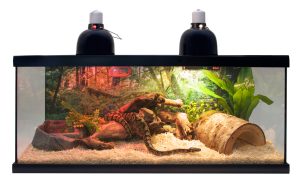Key Things for Reptile and Amphibian Habitats
An enclosure for your reptile or amphibian mimics aspects of its native habitat. This 20-gallon terrarium is set up for a ball python, native to central Africa, that will grow to a length of 5 feet over time. Reptiles need a temperature gradient within their habitat. An incandescent bulb and small logs provide a basking spot for a tropical species, and a thermometer is helpful to keep the tank temperature around 80F. A second UVB light is necessary for the snake to synthesize vitamin D and maintain healthy bones. A hide tunnel is important for this species that naturally inhabits underground burrows. Aspen shavings absorb moisture and are a good substrate for the terrarium.
Temperature
An incandescent light with a reflector will elevate temperature in one end of the habitat for basking. Under-tank heaters are another option for reptile terrariums. Nighttime decreases of 10-15oF mimic climate in natural habitats, but the minimum temperature should always remain in the ideal range for your species.
Humidity
Monitor relative humidity regularly with a hygrometer, and moisten the substrate or mist your pets if necessary. For species from very arid areas, water dishes along with substrate that holds moisture are adequate to maintain humidity.
Light
If your enclosure does not get natural lighting, it will be necessary to add fixtures that emit ultraviolet light (UVB) of the correct wavelengths to promote vitamin D synthesis, required for your pet to maintain its calcium and phosphorus balance which is vital for bone and shell formation. Species from heavily vegetated areas get filtered light, while animals in desert or rocky regions are adapted to high intensity. Tropical species are adapted to 12- hour light/dark cycles.
Substrate
Shredded newspaper, sand, garden soil, peat moss, various wood shavings (avoid cedar which is toxic), coconut fiber, and synthetic carpet. Sand is a good substrate for an aquatic habitat with underwater and terrestrial features. Aspen shavings are popular with snake owners. Burrowing species need several inches of loose material. Absorbent substrates (e.g., coconut fiber) are good choices for amphibians and reptiles adapted to high humidity.
Structure
Add structural components compatible with your pet’s habitat and behavior. Arboreal lizards need limbs or branches for climbing, while aquatic turtles seek out basking logs. A hide box or tube is an essential part of snake habitat. For tropical amphibians such as tree frogs, simulate their natural environment with plants (live or artificial) for climbing and shelter. Outdoor tortoise enclosures need an underground hide box or other shelter.
Containment
Even though the habitat you create will be suited for your pets, herps will often try to explore outside their enclosures. A secure, well-fitting lid with a lock or clip is a must, particularly for snakes that need only a tiny opening to escape. Outdoor enclosures for turtles and tortoises should be set up to prevent burrowing or climbing; also consider measures to deter predators such as raccoons, foxes and birds of prey.